Discover the plants and animals of Pelee Island
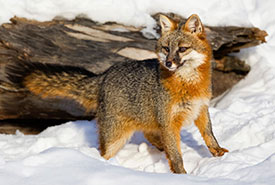
Gray fox (Photo by Ken Canning)
Situated in the relatively shallow, warm, green-blue waters of Lake Erie in Ontario is the 4,179-hectare (10,327-acre) Pelee Island. Mere kilometres from the U.S. border, Canada’s most southerly inhabited island shares a latitude with northern California and has a climate more similar to the Carolinas. Pelee is the largest in a series of islands known as the Western Lake Erie Islands, and provides habitat for many rare species at the far northern edge of their range. Here are just some of the many species that inhabit this special place.
The canids of Pelee Island
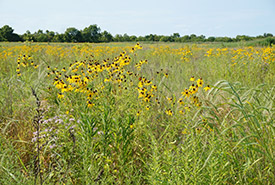
Meadows and forests are habitat for coyotes and red foxes (photo by NCC)
There are three species of canine native to Pelee Island. You are probably familiar with the coyote and red fox, which are common throughout Ontario. But Pelee Island is also home to gray fox, a small mammal that climbs trees like a cat. Gray fox can found throughout the United States, all the way to South America, but Pelee Island is one of only two confirmed breeding populations in Canada.
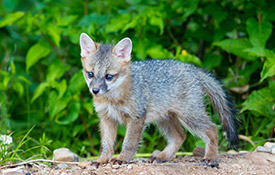
Gray fox kit (photo by Ken Canning)
Coyotes are more often heard than seen. In fact, their scientific name, Canis latrans, means “barking dog,” and they are said to be the most vocal mammal in North America. You can hear their group yip-howls at dusk, especially around the natural areas a Florian Diamante Nature Reserve and Stone Road Alvar in the southeast corner of the island. Coyotes typically live in small family packs and have a diverse diet that includes rabbits, rodents and sometimes other canines.
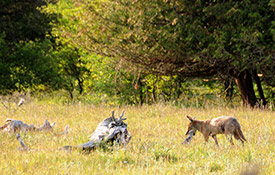
Coyote in an alvar (photo by Bill Macintyre)
Red foxes are well-adapted to life around humans and are the canine species you are most likely to see on the island. They sometimes make dens underneath old buildings, and the kits can be quite bold and curious. If you are lucky, you might see them tumbling and playing in the spring on a lawn or in a farmyard. Red foxes mostly eat mice and other rodents, but will also eat rabbits, insects and reptiles.
Gray foxes are smaller and stubbier than red foxes, and, at a glance, can be mistaken for a raccoon or fluffy cat. They are more sensitive to the presence of humans than coyotes or red foxes, contributing to population declines in parts of their range. Cold winter temperatures may also limit their range in Canada.
Pelee Island: Snail-watching capital of Canada
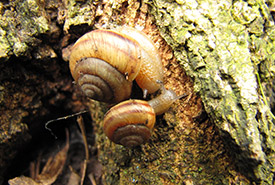
Banded tiger snail (photo by NCC)
Many people come to Pelee Island for the birds, but they are missing out on another unique display of its diversity: snails! These underrated denizens of the duff are not just tasty morsels of French cuisine, they play an important role in the natural ecosystem. Snails eat plants, fungi, decaying materials and even other snails. They are eaten by birds, mammals and reptiles.
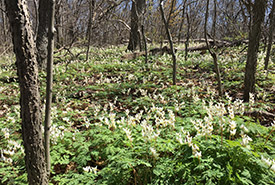
Snail habitat (photo by NCC)
Ontario’s most common snail — the large, yellow-and-brown-striped grove snail — is not actually native to the province. These garden and city dwellers are an invasive species from Europe that can be found throughout Pelee Island.
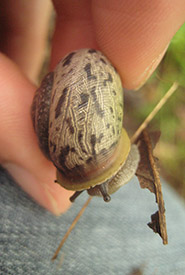
White-lip globe snail (photo by NCC)
Pelee Island is a snail hot spot, featuring over 30 species of land-based snails and slugs, including eight rare species, including broad-banded forestsnail, banded tigersnail and shagreen. Other noteworthy species here include armed snaggletooth and glossy pillar. The large variety of snails on Pelee Island is likely in part due to its unique alvar habitat — shallow soil over limestone. Snails need calcium for their shells, and limestone is high in calcium, making alvars ideal habitat. Snails can get calcium directly from the rock and are important sources of calcium for birds, who need it to build strong eggshells.
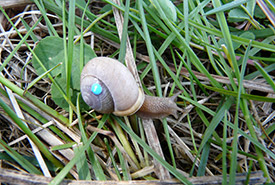
White-lip snail, tagged for research purposes (photo by Annegret Nicolai)
Native snails are not widely studied in Canada, so the exact number of species, where they can be found and their ecology are not well understood. Many of them are now uncommon or rare due to habitat loss, pollution and other factors. As they are poorly equipped for long-distance travel, land-based snails can be seriously threatened by habitat fragmentation. The Nature Conservancy of Canada (NCC) is restoring former agricultural fields on Pelee Island to natural cover, which will eventually be habitat for snails.
Common hoptree and hoptree borer
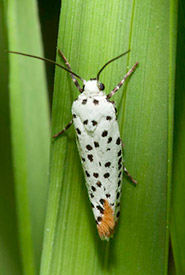
Hoptree borer (photo by John and Jane Balaban)
Thanks to its southern latitude, Pelee Island supports many unique species found almost nowhere else in Canada. Common hoptree is one. A small tree with reddish bark and hop-like seeds, common hoptree likes open shoreline and alvar habitat, and it is at the very northern limit of its range in Ontario. Because its habitat needs are so specific, the common hoptree population is naturally fragmented, making it a species at risk in Ontario.
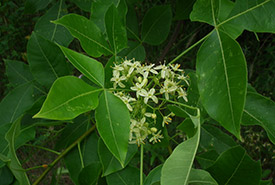
Common hoptree flower (photo by NCC)
The common hoptree supports an even rarer moth: the tiny but striking hoptree borer. This moth is entirely dependent on common hoptrees to survive, and its range is even more limited than its rare host. Hoptree borer caterpillars bore into new stems of common hoptree, where they feed and overwinter. In spring, they emerge to pupate, often in hoptree flowers. Hoptree borers are part of a group called ermine moths, so-called because they are white with black spots like the ermine furs used to trim the coats of past European royalty.
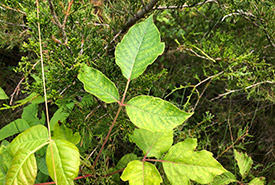
Poison ivy. Common hoptree's three compound leaflets can be confused with poison ivy, but a short middle stem is a giveaway; on poison ivy, the middle stem is much longer than the stems of the side leaflets. (photo by NCC)
You are unlikely to see a hoptree borer if you visit the island, but keep an eye out for common hoptree! This is one of the few places in Ontario where you might see this unusual tree.




